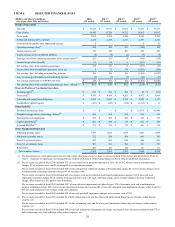Albertsons 2016 Annual Report Download - page 24
Download and view the complete annual report
Please find page 24 of the 2016 Albertsons annual report below. You can navigate through the pages in the report by either clicking on the pages listed below, or by using the keyword search tool below to find specific information within the annual report.22
and the reimbursement formula for multi-source (i.e., generic) drugs. This change will affect the Company’s reimbursement. In
addition, the Patient Protection and Affordable Care Act made other changes that affect the coverage and plan designs that are
or will be provided by many of the Company’s health plan clients, including the requirement for health insurers to meet a
minimum medical loss ratio to avoid having to pay rebates to enrollees. These Patient Protection and Affordable Care Act
changes may not affect the Company’s business directly, but they could indirectly impact the Company’s services and/or
business practices.
The Company may be unable to adequately protect its intellectual property rights, which could harm the Company’s
business.
The Company relies on a combination of trademark, trade secret, copyright and domain name law and internal procedures and
nondisclosure agreements to protect its intellectual property. The Company believes its trademarks, private label products and
domain names are valuable assets. However, the Company’s intellectual property rights may not be sufficient to distinguish the
Company’s products and services from those of its competitors and to provide the Company with a competitive advantage.
From time to time, third parties may use names, logos and slogans similar to the Company’s, may apply to register trademarks
or domain names similar to the Company’s, and may infringe or otherwise violate the Company’s intellectual property rights.
The Company’s intellectual property rights may not be successfully asserted against such third parties or may be invalidated,
circumvented or challenged. Asserting or defending the Company’s intellectual property rights could be time consuming and
costly and could distract management’s attention and resources. If the Company is unable to prevent its competitors from using
names, logos, slogans and domain names similar to the Company’s, consumer confusion could result, the perception of the
Company’s brands and products could be negatively affected, and the Company’s sales and profitability could suffer as a result.
In addition, if the Company’s independent retail customers or Save-A-Lot licensees receive negative publicity or fail to
maintain the quality of the goods and services used in connection with the Company’s trademarks, the Company’s rights to, and
the value of, its trademarks could potentially be harmed. Failure to protect the Company’s proprietary information could also
have an adverse effect on its business.
The Company may also be subject to claims that its activities or the products it sells infringe, misappropriate or otherwise
violate the intellectual property rights of others. Any such claims can be time consuming and costly to defend and may distract
management’s attention and resources, even if the claims are without merit. Such claims may also require the Company to
enter into costly settlement or license agreements (which could, for example, prevent the Company from using its trademarks in
certain geographies or in connection with certain products and services), pay costly damage awards, and face a temporary or
permanent injunction prohibiting the Company from marketing or providing the affected products and services, any of which
could have an adverse effect on the Company’s business.
Severe weather and natural disasters may harm the Company’s business.
Severe weather conditions and natural disasters such as hurricanes, earthquakes, floods, extended winter storms or tornadoes, as
well as other natural disasters, in areas in which the Company or its independent retail customers or licensees have stores,
offices or distribution facilities or from which the Company obtains products may cause physical damage to the Company’s
properties, closure of one or more of the Company’s or its independent retail customers’ or licensees’ stores, offices or
distribution facilities, lack of an adequate work force in a market, temporary disruption in the supply of products, disruption in
the transport of goods, delays in the delivery of goods to distribution centers or stores, a reduction in customer volume and a
reduction in the availability of products in the Company’s or its independent retail customers’ or licensees’ stores. In addition,
adverse climate conditions and adverse weather patterns, such as drought or flood, that impact growing conditions and the
quantity and quality of crops yielded by food producers may adversely affect the availability or cost of certain products within
the grocery supply chain. Any of these factors may disrupt the Company’s businesses and adversely affect the Company’s
financial condition and results of operations.
Disruption to the supply chain and distribution network could have an adverse impact on the Company’s sales and
operating results.
The Company’s sales and operating results could be adversely impacted if the Company is not able to provide goods to the
Company’s stores and its customers’ and licensees’ stores in a timely and cost-effective manner, to maintain continued supply,
pricing or access to new products or to identify alternative sources of merchandise without delay and at similar cost and quality
levels. Additionally, perishable products make up an increasingly significant portion of our sales, and we rely on various
suppliers to provide and deliver our perishable product inventory on a continuous basis.
Factors that may disrupt the Company’s ability to maintain an uninterrupted supply chain and distribution network include
weather, product recalls, crop conditions, regulatory actions, disruptions in technology, political or financial instability for
























